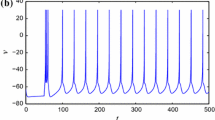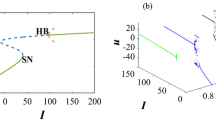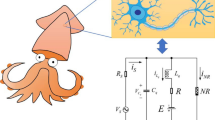Abstract
Fractional-order dynamics is applicable to biological excitable systems with strong interactions or systems with long-term memory effect. The activity of neural membrane voltage depends on the long-range correlations of ionic conductances. Such a behavior of the membrane voltage with long-range correlation can be better described with a fractional-order dynamics. A fractional-order coupled modified three-dimensional (3D) Morris–Lecar (M–L) neural system has been presented to show the variations in the firing patterns from resting state \( \rightarrow \) oscillatory pattern \( \rightarrow \) bursting and the synchronous behavior by designing a bidirectional coupling mechanism. The fractional exponents are lying between 0 and 1. The predominant controller of the changes of firing behavior is the fractional exponent. The stability of synchronization and nature of the fractional system dynamics have been analyzed. To make the investigations more convincing and biologically plausible, we consider a network of M–L oscillators with bidirectional synaptic coupling functions using global type connections and present the effectiveness of the coupling scheme.






Similar content being viewed by others
References
Anderson, R.B.: The power law as an emergent property. Memory Cogn. 29, 1061–1068 (2001)
Gilboa, G., Chen, R., Brenner, N.: History-dependent multiple-time-scale dynamics in a single neuron model. J. Neurosci. 25, 6479–6489 (2005)
Drew, P.J., Abbott, L.F.: Models and properties of power-law adaptation in neural systems. J. Neurophysiol. 96, 826–833 (2006)
Podlubny, I.: Fractional Differential Equations. Academic Press, New York (1999)
Agarwal, O.P., Machado, J.A.T., Sabatier, J.: Special Issue: Fractional Derivatives and Their Applications. Springer Van Godewijckstraat 30, 3311 GZ Dordrecht, Netherlands (2004)
Petras, I.: A note on the fractional-order Chuas systems. Chaos Solitons Fractals 38, 140–147 (2008)
Ortigueira, M.D., Tenreiro Machado, J.A.: What is a fractional derivative? J. Comput. Phys. 293, 4–13 (2015)
Zhou, Y., Ionescu, C., Tenreiro Machado, J.A.: Fractional dynamics and its applications. Nonlinear Dyn. 80, 1661–1664 (2015)
Anastasio, T.J.: The fractional-order dynamics of brainstem vestibule oculomotor neurons. Biol. Cybern. 72, 69–79 (1994)
Doehring, T.C., Freed, A.D., Carew, E.O., Vesely, I.: Fractional order viscoelasticity of the aortic valve cusp: an alternative to quasilinear viscoelasticity. J. Biomech. Eng. 127, 700–708 (2005)
Grahovac, N.M., Zigic, M.M.: Modelling of the hamstring muscle group by use of fractional derivatives. Comput. Math. Appl. 59, 1695–1700 (2010)
Goychuk, I., Hanggi, P.: Fractional diffusion modeling of ion channel gating. Phys. Rev. E 70, 051915 (2004)
Lundstrom, B.N., Higgs, M.H., Spain, W.J., Fairhall, A.L.: Fractional differentiation by neocortical pyramidal neurons. Nat. Neurosci. 11, 1335–1342 (2008)
Langlands, T., Henry, B., Wearne, S.: Fractional cable equation models for anomalous electro diffusion in nerve cells: infinite domain solutions. J. Math. Biol. 59, 761–808 (2009)
Moaddy, K., Radwan, A., Salama, K., Momani, S., Hashim, I.: The fractional order modeling and synchronization of electrically coupled neuron systems. Comput. Math. Appl. 64, 3329–3339 (2012)
Teka, W., Marinov, T.M., Santamaria, F.: Neuronal spike timing adaptation described with a fractional leaky integrate-and-fire model. PLoS Comput. Biol. 10(3), e1003526 (2014)
Ahmad, W.M., Sprott, J.C.: Chaos in fractional-order autonomous nonlinear systems. Chaos Solitons Fractals 16, 339–351 (2003)
Grigorenko, I., Grigorenko, E.: Chaotic dynamics of the fractional Lorenz system. Phys. Rev. Lett. 91(3), 034101 (2006)
Pikovsky, A., Rosenblum, M., Kurths, J.: Synchronization—A Universal Concept in Nonlinear Science. Cambridge University Press, Cambridge (2001)
Li, C.G., Liao, X.F., Yu, J.B.: Synchronization of fractional order chaotic systems. Phys. Rev. E 68, 067203 (2003)
Deng, W.H., Li, C.P.: Chaos synchronization of the fractional Lu system. Phys. A 353, 61–72 (2005)
Abarbanel, H.D.I., Huerta, R., Rabinovich, M.I., Rulkov, N.F., Rovat, P.F., Selverston, A.I.: Synchronized action of synaptically coupled chaotic model neurons. Neural Comput. 8(8), 1567–1602 (1996)
Elson, R.C., Selverston, A.I., Huerta, R., Rulkov, N.F., Rabinovich, M.I., Abarbanel, H.D.I.: Synchronous behavior of two coupled biological neurons. Phys. Rev. Lett. 81, 5692–5695 (1998)
Ma, J., Li, F., Huang, L., Jin, W.Y.: Complete synchronization, phase synchronization and parameters estimation in a realistic chaotic system. Commun. Nonlinear Sci. Numer. Simul. 16, 3770–3785 (2011)
Sun, A., Lu, L., Li, C.: Synchronization of an uncertain small-world neuronal network based on modified sliding mode control technique. Nonlinear Dyn. 82, 1905–1912 (2015)
Zhang, F., Chen, G., Li, C., Kurths, J.: Chaos synchronization in fractional differential systems. Phil. Trans. R. Soc. A 371, 20120155 (2013)
Bao, H.B., Cao, J.: Pojective synchronization of fractional-order memristor-based neural networks. Neural Netw. 63, 1–9 (2015)
Velmurugan, G., Rakkiyappan, R., Cao, J.: Finite-time synchronization of fractional-order memristor-based neural networks. Neural Netw. 73, 36–46 (2016)
Agrawal, S.K., Srivastava, M., Das, S.: Synchronization of fractional order chaotic systems using active control method. Chaos Solitons Fractals 45, 737–752 (2012)
Srivastava, M., Ansari, S.P., Agrawal, S.K., Das, S., Leung, A.Y.T.: Anti-synchronization between identical and non-identical fractional order chaotic systems using active control method. Nonlinear Dyn. 76, 905–914 (2014)
Leung, A.Y.T., Li, X.F., Chu, Y.D., Rao, X.B.: Synchronization of fractional-order chaotic systems using unidirectional adaptive full-state linear error feedback coupling. Nonlinear Dyn. 82, 185–199 (2015)
Cuomo, K.M., Oppenheim, A.V.: Circuit implementation of synchronized chaos with application to communication. Phys. Rev. Lett. 71, 65–68 (1993)
Yang, N., Liu, C.: A novel fractional-order hyperchaotic system stabilization via fractional sliding-mode control. Nonlinear Dyn. 74, 721–732 (2013)
Gao, L., Wang, Z., Zhou, K., Zhu, W., Wu, Z., Ma, T.: Modified sliding mode synchronization of typical three-dimensional fractional-order chaotic systems. Neurocomputing 166, 53–58 (2015)
Ren, F., Cao, F., Cao, J.: Mittag–Leffler stability and generalized Mittag–Leffler stability of fractional-order gene regulatory networks. Neurocomputing 160, 185–190 (2015)
Mahmoud, G.M., Abed-Elhameed, T.M., Ahmed, M.E.: Generalization of combinationcombination synchronization of chaotic n-dimensional fractional-order dynamical systems. Nonlinear Dyn. 83, 1885–1893 (2016)
Izhikevich, E.M.: Neural excitability, spiking and bursting. Int. J. Bifurc. Chaos 10(06), 1171–1266 (2000)
Izhikevich, E.M.: Which model to use for cortical spiking neurons? IEEE Trans. Neural Netw. 15, 1063–1070 (2004)
Shi, M., Wang, Z.: Abundant bursting patterns of a fractional-order Morris–Lecar neuron model. Commun. Nonlinear Sci. Numer. Simul. 19, 1956–1969 (2014)
Kopell, N., Ermentrout, B.: Chemical and electrical synapses perform complementary roles in the synchronization of inter neuronal networks. Proc. Natl. Acad. Sci. USA 101(43), 15482–15487 (2004)
Skinner, F.K., Zhang, L., Velazquez, J.L.P., Carlen, P.L.: Bursting in inhibitory interneuronal networks: a role for gap-junctional coupling. J. Neurophysiol. 81(3), 1274–1283 (1999)
Padmanaban, E., Hens, C., Dana, S.K.: Engineering synchronization of chaotic oscillators using controller based coupling design. Chaos 21, 013110 (2011)
Tavazoei, M.S., Haeri, M.: A necessary condition for double scroll attractor existence in fractional order systems. Phys. Lett. A 367, 102–113 (2007)
Muthukumar, P., Balasubramaniam, P., Ratnavelu, K.: Synchronization and an application of a novel fractional order King Cobra chaotic system. Chaos 24, 033105 (2014)
Magin, R.L.: Fractional calculus in bioengineering. Crit. Rev. Biomed. Eng. 32, 1–104 (2004)
Ahmed, E., El-Sayed, A.M.A., El-Saka, H.A.A.: On some Routh–Hurwitz conditions for fractional order differential equations and their applications in Lorenz, Rssler, Chua and Chen systems. Phys. Lett. A 358, 1–4 (2006)
Wolf, A., Swift, J.B., Swinney, H.L., Vastano, J.A.: Determining Lyapunov exponenets from a time series. Physica 16D, 285–317 (1985)
Belykh, I., de Lange, E., Hasler, M.: Synchronization of bursting neurons: what matters in the network topology. Phys. Rev. Lett. 94(18), 188101 (2005)
HuiXin, Q., Ma, J., WuYin, J., ChunNi, W.: Dynamics of electric activities in neuron and neurons of network induced by autapses. Sci. China 57, 936–946 (2014)
Jhou, F.J., Juang, J., Liang, Y.H.: Multistate and multistage synchronization of Hindmarsh–Rose neurons with excitatory and electrical synapses. IEEE Trans. Circuits Syst. 59(6), 1335–1347 (2012)
Author information
Authors and Affiliations
Corresponding author
Appendix
Appendix
The numerical computations of nonlinear fractional order systems have various approximation techniques. We use the Caputo fractional derivative and consider the predictor–corrector algorithm technique to solve the fractional order system as well as the coupled system to show the synchronization effect. The scheme is based on the Adams–Bashforth–Moulton method [17, 29, 43]. This is a time domain approximation scheme. We analyze the method as follows. Consider the fractional order system as
where \({x^{(m)}}(0) = x_0^{(m)},\,\,m = 1,\,\,2,\ldots ,\,\,k - 1.\) The above fractional order system is equivalent to Volterra integral equation
consider \(h = T/N,\,\,{t_n} = nh\,\,(n = 0,\,\,1,\,\,2,\ldots ,\,\,N).\) The above integral equation can be solved in the following way
where
and \({\beta _{i,n + 1}} = ({{{h^\gamma }} / \gamma })({(n + 1 - i)^\gamma } - {(n - i)^\gamma }),\) then the discretized function becomes \(x_h^\gamma ({t_{n + 1}}) = \sum \nolimits _{m = 0}^{\left\lceil \gamma \right\rceil - 1} {x_0^{(m)}({{{t^m}} / {m!}})} + ({1 / {\varGamma (\gamma )}})\sum \nolimits _{i = 0}^n {\beta _{i,n + 1}}G({t_i},{x_h}({t_i})).\) The error dynamics function of the above approximation is expressed as follows: \( \max \nolimits _{i = 1,\,\,2,\ldots ,\,\,N} \left| {x({t_i}) - {x_h}({t_i})} \right| = O({h^r}),\) where \(r = \min (2,\,\,1 + \gamma ).\) Using the above mentioned procedure, the nonlinear system of initial value fractional order system can be discretized and solved numerically.
Rights and permissions
About this article
Cite this article
Upadhyay, R.K., Mondal, A. & Teka, W.W. Fractional-order excitable neural system with bidirectional coupling. Nonlinear Dyn 87, 2219–2233 (2017). https://doi.org/10.1007/s11071-016-3185-3
Received:
Accepted:
Published:
Issue Date:
DOI: https://doi.org/10.1007/s11071-016-3185-3




